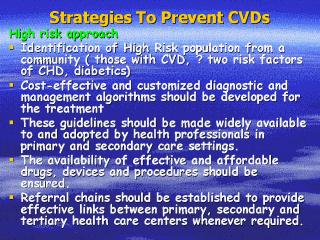| front |1 |2 |3 |4 |5 |6 |7 |8 |9 |10 |11 |12 |13 |14 |15 |16 |17 |18 |19 |20 |21 |22 |23 |24 |25 |26 |27 |28 |29 |30 |31 |32 |33 |34 |35 |36 |37 |review |
 |
Cost-effective and
customized diagnostic and management algorithms should be developed for the
treatment of all common cardiovascular diseases. These guidelines should be
made widely available in the region. The availability of effective and affordable drugs, devices and procedures should be ensured. Referral chains should be established which should provide effective links between primary, secondary and tertiary health care centers whenever required. Train the trainers" approach should be adopted for promoting CVD prevention at the professional level. All physicians must commit the time to make a proper assessment and initiate preventive efforts. Physician's advocacy of healthy habits including tobacco-use cessation, healthy eating, weight control, and physical activity should be universal. Physicians in South Asia usually lack support of related health professionals such as dietitians and the support services of specialized anti-smoking, weight reduction and diabetic clinics, as is the norm in the developed world. Therefore a customized risk management curriculum should be introduced for physicians and health professionals during the course of formal and informal training. " Specialist opinion should be sought whenever essential and feasible. The cut-off points for specialist referral for every risk category should be recognized. Suitable clinical algorithms for diagnosis and low-cost life-saving interventions (eg, aspirin) must be widely available to and adopted by health professionals in primary and secondary care settings. |